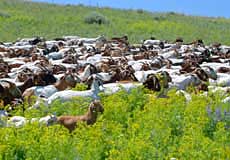Praxis
Profile: Herding Goats in Montana
By Laura Jean
Schneider ’10
 As a Landscape Studies
minor, I’m interested in creative
and ecologically sound solutions to controversial landscape
issues. So when I discovered Terra Vita Grazing and Consulting,
an alternative weed management company based in Wyoming,
I inquired about a summer internship with the owners, Brandon
and Brandy Dalton. They were receptive to the idea, but funding
was an issue. I applied for funding with Smith’s Praxis
program, and one month later headed to Two Dot, Montana,
where I began my job helping herd more than 900 doe and kid
goats on a 20,000-acre ranch. As a Landscape Studies
minor, I’m interested in creative
and ecologically sound solutions to controversial landscape
issues. So when I discovered Terra Vita Grazing and Consulting,
an alternative weed management company based in Wyoming,
I inquired about a summer internship with the owners, Brandon
and Brandy Dalton. They were receptive to the idea, but funding
was an issue. I applied for funding with Smith’s Praxis
program, and one month later headed to Two Dot, Montana,
where I began my job helping herd more than 900 doe and kid
goats on a 20,000-acre ranch.
It’s hard to convince people that weeds aren’t
necessarily bad. They are a natural part of biodiversity,
after all, and completely eradicating them would be harmful.
However, when invasive species compete with native species
the landscape can alter drastically, changing habitat and
upsetting delicate ecosystems. In many parts of Wyoming and
Montana, the constant drought and subsequent brittle conditions
provide the exact environment that gives hardier invasive
plants—such as many weeds—an advantage.

A goatherd under Schneider's
charges devours Leafy Spurge weeds on a Montana hillside.
|
Fortunately, goats are perfect for managing weeds in these
conditions. Plants like Death Camas, (Zigadenus nuttalli A.),
which is fatal to domestic stock, and invasive species like
Leafy Spurge (Euphorbia esula) are no match for
goats. Goats can tolerate toxic alkaloids and digest weed
seeds so completely that they are no longer able to germinate,
halting weed spread. Goats also strip the bark of invasive
shrubs and devour leaves, plants stalks and flower heads,
severely stressing undesirable plants.
There are several ways
to maximize weed grazing. Loose grazing is best for large
areas with low to moderate weed infestation. A working
dog is essential for this method: from experience I learned
it is impossible to direct a scattered herd of goats on
foot without a dog’s help. After a day of
loose grazing the herd is penned in a temporary electric
fence for the night.
In addition to keeping the goats safe from predators, penning
is also a grazing tool. Areas of dense weed infestation need
more impact than loose grazing can provide. Concentrating
the goats in a small area ensures that manure and organic
material (such as trampled grass and weeds) gets thoroughly
worked into the soil. Over time, this changes the composition
of the soil itself, allowing native species to compete with
invasive weeds.
Every aspect of this job,
from having to bottle-feed “bums” (orphaned
kids) to trouble-shooting job sites, has helped me appreciate
the process that healthy, balanced land requires. Through
the course of my job, I’ve changed my emphasis from
focusing on weeds to focusing on soil. It’s most satisfying
to see the weeds disappear, but building healthy
soil is the critical contribution to renewing native biodiversity.
Herding goats taught me that healthy, weed-free land is
possible. And it all starts from the ground up. |























